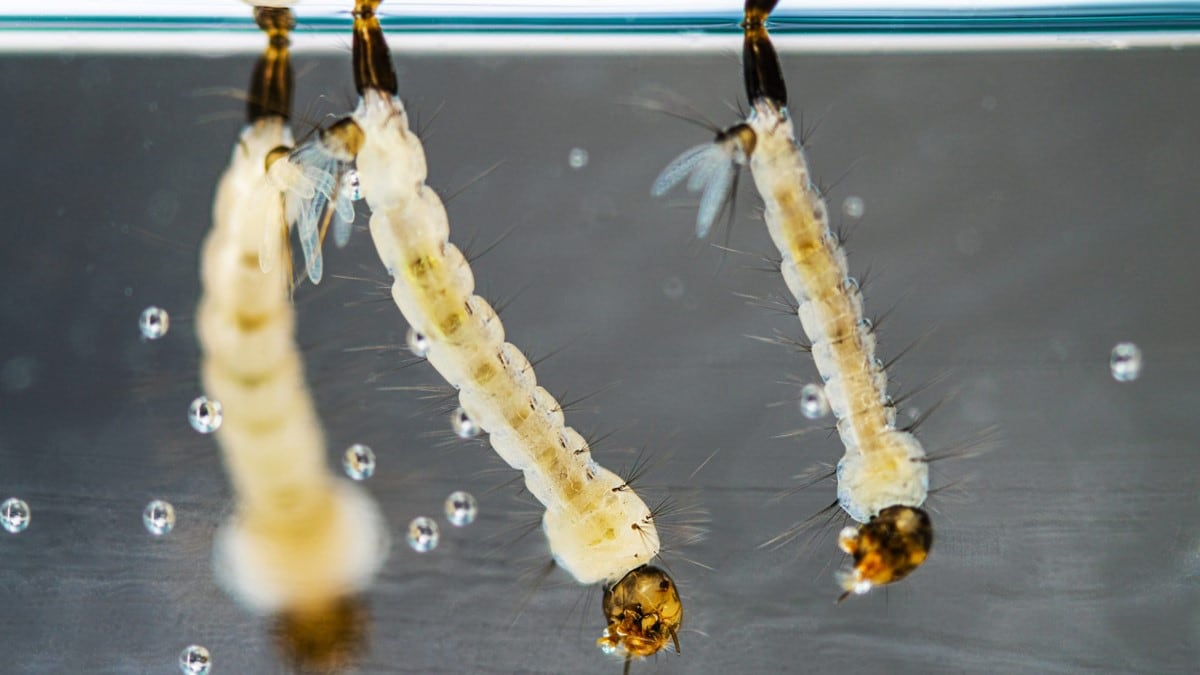What to know
- Larvicides are a type of insecticide used to control mosquitoes indoors and outdoors.
- Homeowners and professionals can use larvicides to kill mosquito larvae and pupae before they can grow into biting adult mosquitoes.
- When used according to product label instructions, larvicides do not harm people, pets, or the environment.

Overview
Some larvicides are activated when eaten by the mosquitoes, and some types work when they come into contact with larvae.
Homeowners can use mosquito dunks or bits that contain larvicide. Larvicides can be applied by hand to small bodies of water in the yard and community.
Mosquito control professionals can also apply larvicides. Licensed mosquito control professionals apply Environmental Protection Agency (EPA)-registered larvicides using backpack sprayers, trucks, or airplanes depending on the size of the area being affected. During an outbreak, local government departments and mosquito control districts take the lead for large-scale mosquito control activities.
Forms of larvicides

- Dunks, tablets, bits, pellets, granules, briquettes: These forms of larvicide are also applied to areas where mosquitoes lay eggs.
- Liquids: Liquid larvicide products are applied directly to water using backpack sprayers and truck- or aircraft-mounted sprayers.
Information for homeowners
Areas you can treat with larvicides
Use larvicides where mosquitoes lay eggs to help reduce the number of mosquitoes in an area. Follow the instructions on the label. Do not apply more than directed or reapply more often than instructed.
Mosquitoes lay eggs in items that hold water:
- Buckets and rain barrels
- Fountains
- Gutters or downspouts
- Non-chlorinated swimming pools
- Pool covers that collect water
- Tires
- Tree holes
Use larvicides to treat standing water that
- Will not be used for drinking
- Cannot be covered, dumped, or removed
Hire a pest control professional if preferred
Hire a pest control professional to treat your yard and outdoor areas. The National Pest Management Association offers tips on finding a pest control professional.
Information for professionals
EPA-registered larvicides have been studied for their effectiveness and safety when used according to label instructions. Public health officials and mosquito control professionals use three types of larvicides: bacterial larvicides, insect growth regulators, and oils and films.
Bacterial larvicides
The following types of larvicides are made from natural substances.
- The bacterium Bacillus thuringiensis subspecies israelensis (Bti) is found in the soil. Bti is toxic to mosquito larvae, blackflies, and fungus gnats.
- Bti has been used for mosquito control for more than 30 years.
- Bti does not control biting female mosquitoes.
- Bti has been used for mosquito control for more than 30 years.
- The bacterium Saccharopolyspora spinosa is found in soil. It is toxic to mosquitoes, ants, fruit flies, and other insects. Spinosad is a commercial larvicide derived from this bacterium.
- The bacterium Lysinibacillus sphaericus (also known as Bacillus sphaericus) is found in soil. It works well on some mosquito species but does not work on Aedes aegypti.
Insect growth regulators
These types of larvicides prevent mosquito larvae from completing their immature stage, so they do not make it to the adult stage. Methoprene and pyriproxyfen are examples of insect growth regulators.
Oils and films
Licensed mosquito control professions use mineral oils and films to kill mosquito larvae and pupae.
- Mineral oils and films, when applied to water, spread in a thin layer over the surface of the water.
- Mosquito larvae and pupae that breathe at the water's surface drown.
- Using mineral oils and films are the only effective methods for killing pupae.
Information on insecticides and health
- EPA oversees registration of these chemicals.
- The National Pesticide Information Center (NPIC) provides information online or through a toll-free number, 1-800-858-7378.
